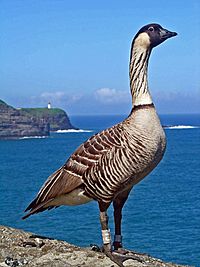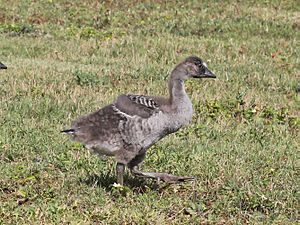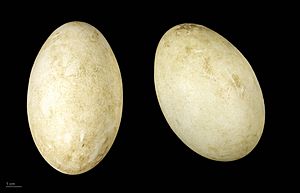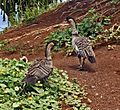Nene (bird) facts for kids
Quick facts for kids Hawaiian Goose |
|
|---|---|
 |
|
| Conservation status | |
| Scientific classification | |
| Kingdom: | |
| Phylum: | |
| Class: | |
| Order: | |
| Family: | |
| Genus: | |
| Species: |
B. sandvicensis
|
| Binomial name | |
| Branta sandvicensis (Vigors, 1833)
|
|
The Nēnē, also known as the Hawaiian Goose, is a special type of goose. You can only find it on a few Hawaiian islands today. Its name comes from the soft sound it makes.
This goose is easy to spot with its brown feathers and darker head. Its strong toes have less webbing than other water birds. This helps it walk on the lava rock where it builds its nests. The Nēnē spends more time on land than most other geese. When it is moulting, which means dropping old feathers and growing new ones, the Nēnē cannot fly. This made it easy to hunt in the past.
The Nēnē was once one of the most threatened waterfowl in the world. There used to be many Nēnē, but hunting and new predators brought to the islands, like mongooses, pigs, and cats, caused their numbers to drop. By the 1950s, there were only about 30 birds left. Luckily, Nēnē breed well in captivity, like in zoos. Many have been successfully released back into the wild. You can also find good numbers of them in bird parks.
The Nēnē is the official state bird of Hawaii.
Contents
Meet the Nēnē: Description and Size
The Nēnē is a medium-sized goose. It stands about 41 cm (16 in) tall. Even though they spend most of their time on the ground, they can fly. Some Nēnē even fly daily between their nesting and feeding spots.
Female Nēnē usually weigh between 1.525–2.56 kg (3.36–5.64 lb). Males are a bit bigger, weighing about 1.695–3.05 kg (3.74–6.72 lb). Adult males have a black head and the back of their neck is also black. Their cheeks are a light brown color, and their neck has cool black and white stripes. Female Nēnē look similar to males but are a bit smaller. The bill, legs, and feet of an adult Nēnē are black. They also have soft feathers under their chin. Young Nēnē, called goslings, look like the males but are a duller brown. Their head and neck colors are not as clear, and their stripes are less noticeable.
Where Nēnē Live: Habitat and Range
Nēnē live in different types of areas. These include shrubland, grassland, coastal dunes, and lava plains. They also live in places changed by humans, like pastures and golf courses. You can find them from sea level up to 2,400 m (7,900 ft) high. Some groups of Nēnē used to fly between their breeding grounds in lowlands and feeding areas in the mountains.
Long ago, Nēnē could be found on many Hawaiian islands. These included Hawaiʻi, Maui, Kahoʻolawe, Lānaʻi, Molokaʻi, and Kauaʻi. Today, they only live on Hawaiʻi, Maui, Molokaʻi, and Kauaʻi. In 2014, a pair of Nēnē arrived at the James Campbell National Wildlife Refuge on Oʻahu. Two of their babies survived and are often seen on nearby golf courses.
Nēnē Life: Breeding and Diet
Breeding and Life Cycle
The Nēnē breeding season is very long, lasting from August to April. This is longer than any other goose. Most eggs are laid between November and January. Unlike most other waterfowl, Nēnē mate on land.
Female Nēnē build their nests in a spot they choose. They lay between one and five eggs. On Maui and Hawaiʻi, they usually lay three eggs. On Kauaʻi, they often lay four. The female sits on the eggs for 29 to 32 days to keep them warm. During this time, the male Nēnē stands guard to protect the nest.
Baby Nēnē, called goslings, are born ready to feed themselves. They stay with their parents until the next breeding season.
What Nēnē Eat: Diet
The Nēnē is a herbivore, meaning it only eats plants. It will either graze (eat grass) or browse (eat leaves and twigs), depending on what plants are available. Their food includes the leaves, seeds, fruit, and flowers of grasses and shrubs.
Saving the Nēnē: Conservation Efforts
The Nēnē is the rarest goose in the world. It is thought that about 25,000 Hawaiian geese lived in Hawaiʻi when Captain James Cook arrived in 1778. But hunting and new predators, like small Asian mongooses, pigs, and cats, caused their numbers to drop. By 1952, there were only 30 birds left.
Luckily, Nēnē breed well when cared for by humans. They have been successfully released back into the wild. In 2004, it was estimated that there were 800 birds living in the wild. Another 1,000 were in bird collections and zoos. There is some concern about inbreeding because the starting group of birds was so small.
The nature reserve WWT Slimbridge in England played a big part in saving the Hawaiian goose. Under the guidance of conservationist Peter Scott, Nēnē were bred there in the 1950s. This helped bring them back from almost disappearing. Later, they were released back into the wild in Hawaiʻi. You can still see Hawaiian geese at Slimbridge today. They are also found in captivity at every WWT center. Successful releases have happened at Haleakala and Piʻiholo ranches on Maui. Today, the Nēnē population is around 2,500 birds.
Gallery
-
A Nēnē at WWT Slimbridge in England
-
A Nēnē egg signed by Peter Scott
Images for kids
-
Two Nēnē calling out at Kīlauea Point
See also
 In Spanish: Ganso nené para niños
In Spanish: Ganso nené para niños

















